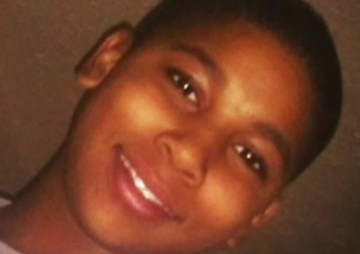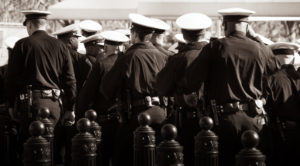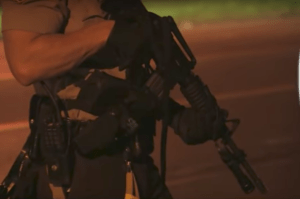2015: The Year Police Killings in America Were Counted
Heightened visibility alone, however, has not effectively ended such slayings or brought justice to victims. Protest over the killing of Tamir Rice continued throughout this year. The 12-year-old was fatally shot by Cleveland police in November of 2014. (Screen shot / YouTube)
Protest over the killing of Tamir Rice continued throughout this year. The 12-year-old was fatally shot by Cleveland police in November of 2014. (Screen shot / YouTube)
By Sarah Lazare / Common Dreams
Protest over the killing of Tamir Rice continued throughout this year. The 12-year-old was fatally shot by Cleveland police in November of 2014. (Screen shot / YouTube)
This piece originally ran on Common Dreams.
The Black Lives Matter movement that swept the country in 2015 has—among other accomplishments—forced global media outlets to afford victims of police killings the most basic acknowledgement: a public record of their names and deaths.
Such a grim tally was maintained this year by both the Guardian and the Washington Post, following the consistent failure of the U.S. government to keep adequate records.
According to the Guardian, 1,126 people were killed by police so far in 2015, averaging more than three a day, with 27 percent of those slain facing mental health issues.
The numbers confirm the racial injustices highlighted by nationwide protests. Among black people in America, 6.9 per million were killed by police, compared to 2.86 white people per million. In other words, African-Americans were nearly 2.5 times as likely to be killed by police as their white counterparts.
Native-Americans and Latinos were also disproportionately likely to have their lives taken by law enforcement, with 3.4 per million and 3.35 per million killed respectively.
The high number of killings was corroborated by the Washington Post, which only tracks fatal police shootings—not killings by taser, beating, and other forms of force, such as the high-profile death of African-American man Freddie Gray in Baltimore. The paper concluded, nonetheless, that nearly 1,000 civilians were shot and killed by police this year.
What’s more, the Post’s analysis found that the FBI, which is tasked with tracking such shootings, is dramatically undercounting killings because “fewer than half of the nation’s police departments report their incidents to the agency.”
“The Post documented well more than twice as many fatal shootings this year as the average annual tally reported by the FBI over the past decade,” journalists Kimberly Kindy, Marc Fisher, Julie Tate, and Jennifer Jenkins reported this week.
However, Jim Naureckas, editor of Fairness & Accuracy In Reporting’s watchdog journal Extra!, argued Tuesday that the Post also “held back” key information by downplaying the connection between the high number of police killings and the grievances issued by racial justice movements.
For example, Post journalists wrote that “the kind of incidents that have ignited protests in many U.S. communities—most often, white police officers killing unarmed black men—represent less than 4 percent of fatal police shootings.”
But in fact, the Black Lives Matter movement has condemned killings by officers of all races, killings of people who were armed, and killings of black women—such as Mya Hall and Rekia Boyd—by police as well as vigilante violence.
Even still, the Post‘s numbers are damning.
“Although black men make up only 6 percent of the U.S. population, they account for 40 percent of the unarmed men shot to death by police this year,” the paper’s database found. “In the majority of cases in which police shot and killed a person who had attacked someone with a weapon or brandished a gun, the person who was shot was white. But a hugely disproportionate number—3 in 5—of those killed after exhibiting less threatening behavior were black or Hispanic.”
There are many things that the databases don’t track, including beatings, abuse, and sexual assaults. For example, police officer Daniel Holtzclaw’s serial raping of African-American women would not make it on this list of atrocities.
But perhaps, more than anything, both databases show that heightened visibility, in itself, will not end police killings or bring justice to its victims.
The end of 2015 is being marked by ongoing protests demanding “Justice for Tamir Rice,” a 12-year-old African-American shot to death by a white police officer while playing with a toy gun. An Ohio Grand Jury decided Monday not to indict officers Timothy Loehmann or Frank Garmback, despite video evidence that neither provided first aid to the dying child.
In a statement released Monday night, Tamir’s mother, Samaria Rice, declared: “I don’t want my child to have died for nothing and I refuse to let his legacy or his name be ignored. We will continue to fight for justice for him, and for all families who must live with the pain that we live with.”
Your support matters…Independent journalism is under threat and overshadowed by heavily funded mainstream media.
You can help level the playing field. Become a member.
Your tax-deductible contribution keeps us digging beneath the headlines to give you thought-provoking, investigative reporting and analysis that unearths what's really happening- without compromise.
Give today to support our courageous, independent journalists.






You need to be a supporter to comment.
There are currently no responses to this article.
Be the first to respond.